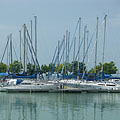
 Туристическая информация
Туристическая информация
(Оптимизирована для устройств с небольшим экраном)
Józsefváros, Keleti Railway Station - Будапешт, Венгрия
При нажатии:
Нажмите на изображении!
-

The Keleti Train Station with the half covered modern pedestrian subway system
Дата фотографии: 10.06.20142014
Создано: Роберт Немет
Модель камеры: Konica Minolta Dimage A200
Будапешт, Венгрия
-

The new subway and the Keleti Railway Station
Дата фотографии: 10.06.20142014
Создано: Роберт Немет
Модель камеры: Konica Minolta Dimage A200
Будапешт, Венгрия
-

Wide stairs in the platform hall (or Great Hall)
Дата фотографии: 20.09.20132013
Создано: Роберт Немет
Модель камеры: Konica Minolta Dimage A200
Будапешт, Венгрия
-
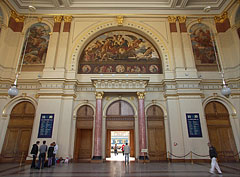
The decorated waiting hall of the Keleti Railway Station (the so-called Lotz Hall)
Дата фотографии: 20.09.20132013
Создано: Роберт Немет
Модель камеры: Konica Minolta Dimage A200
Будапешт, Венгрия
-
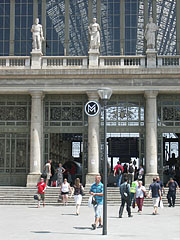
The main entrance of the Keleti Railway Station
Дата фотографии: 10.06.20142014
Создано: Роберт Немет
Модель камеры: Konica Minolta Dimage A200
Будапешт, Венгрия
-
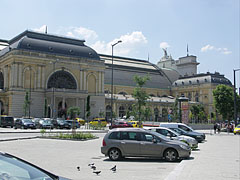
Parking lot and the north side of the Keleti Train Terminal building
Дата фотографии: 10.06.20142014
Создано: Роберт Немет
Модель камеры: Konica Minolta Dimage A200
Будапешт, Венгрия
-
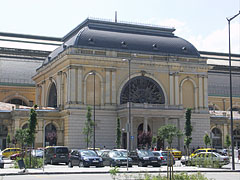
The north entrance of the Keleti Train Station, the departure lounge and ornate waiting hall from outside
Дата фотографии: 10.06.20142014
Создано: Роберт Немет
Модель камеры: Konica Minolta Dimage A200
Будапешт, Венгрия
-

The ornate departure hall of the Keleti Railroad Station from outside
Дата фотографии: 10.06.20142014
Создано: Роберт Немет
Модель камеры: Konica Minolta Dimage A200
Будапешт, Венгрия
-
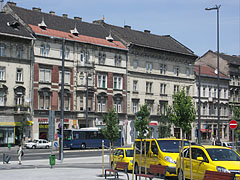
Four-story residental buildings and yellow taxies in the north side of the Baross Square
Дата фотографии: 10.06.20142014
Создано: Роберт Немет
Модель камеры: Konica Minolta Dimage A200
Будапешт, Венгрия
-
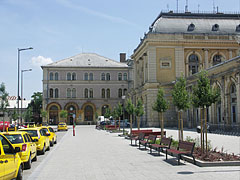
Taxi stand and small park in the north part of the Baross Square, near the Keleti Railway Station
Дата фотографии: 10.06.20142014
Создано: Роберт Немет
Модель камеры: Konica Minolta Dimage A200
Будапешт, Венгрия
-
The main post office at the Keleti Train Terminal
Дата фотографии: 10.06.20142014
Создано: Роберт Немет
Модель камеры: Konica Minolta Dimage A200
Будапешт, Венгрия
The main post office at the Keleti Train Terminal - Будапешт, Венгрия -
The nort side of the Keleti Train Terminal
Дата фотографии: 10.06.20142014
Создано: Роберт Немет
Модель камеры: Konica Minolta Dimage A200
Будапешт, Венгрия
The nort side of the Keleti Train Terminal - Будапешт, Венгрия -
The "Agriculture" wall painting in the Lotz Hall
Created by Károly Lotz Hungarian painter in 1884.
Дата фотографии: 10.06.20142014
Создано: Роберт Немет
Модель камеры: Konica Minolta Dimage A200
Будапешт, Венгрия
The "Agriculture" wall painting in the Lotz Hall - Будапешт, Венгрия -
The Lotz Hall of the railway station
Дата фотографии: 10.06.20142014
Создано: Роберт Немет
Модель камеры: Konica Minolta Dimage A200
Будапешт, Венгрия
The Lotz Hall of the railway station - Будапешт, Венгрия -
Lotz Hall in the train station
Дата фотографии: 10.06.20142014
Создано: Роберт Немет
Модель камеры: Konica Minolta Dimage A200
Будапешт, Венгрия
Lotz Hall in the train station - Будапешт, Венгрия -
The Lotz Hall is the former departure hall
The titles of the murals: "Bridge construction" and "Post", artworks of Károly Lotz from 1884.
Дата фотографии: 10.06.20142014
Создано: Роберт Немет
Модель камеры: Konica Minolta Dimage A200
Будапешт, Венгрия
The Lotz Hall is the former departure hall - Будапешт, Венгрия -
The "Trade" allegorical wall painting in the Lotz Hall
Created by Károly Lotz Hungarian painter in 1884.
Дата фотографии: 10.06.20142014
Создано: Роберт Немет
Модель камеры: Konica Minolta Dimage A200
Будапешт, Венгрия
The "Trade" allegorical wall painting in the Lotz Hall - Будапешт, Венгрия -
The ornate Lotz Hall
Дата фотографии: 10.06.20142014
Создано: Роберт Немет
Модель камеры: Konica Minolta Dimage A200
Будапешт, Венгрия
The ornate Lotz Hall - Будапешт, Венгрия -
The interior of the main hall, also known as train shed or overall roof in the Keleti Railway Station
The dimensions of the hall: 188 meters in length, 44 meters in width and 31.5 meters in height.
Дата фотографии: 10.06.20142014
Создано: Роберт Немет
Модель камеры: Konica Minolta Dimage A200
Будапешт, Венгрия
The interior of the main hall, also known as train shed or overall roof in the Keleti Railway Station - Будапешт, Венгрия -
The view of the square from the main entrance of the Keleti Train Terminal
Дата фотографии: 10.06.20142014
Создано: Роберт Немет
Модель камеры: Konica Minolta Dimage A200
Будапешт, Венгрия
The view of the square from the main entrance of the Keleti Train Terminal - Будапешт, Венгрия -
Stairs at the main entrance of the Keleti Railway station
Дата фотографии: 10.06.20142014
Создано: Роберт Немет
Модель камеры: Konica Minolta Dimage A200
Будапешт, Венгрия
Stairs at the main entrance of the Keleti Railway station - Будапешт, Венгрия -
A renovated old residental building on the Baross Square, viewed from the stairs of the Keleti Train Station
Дата фотографии: 10.06.20142014
Создано: Роберт Немет
Модель камеры: Konica Minolta Dimage A200
Будапешт, Венгрия
A renovated old residental building on the Baross Square, viewed from the stairs of the Keleti Train Station - Будапешт, Венгрия -
The main hall of the Keleti Railway Station
Дата фотографии: 10.06.20142014
Создано: Роберт Немет
Модель камеры: Konica Minolta Dimage A200
Будапешт, Венгрия
The main hall of the Keleti Railway Station - Будапешт, Венгрия -
Baross Square
Дата фотографии: 10.06.20142014
Создано: Роберт Немет
Модель камеры: Konica Minolta Dimage A200
Будапешт, Венгрия
Baross Square - Будапешт, Венгрия -
The new pedestrian subway system in Baross Square
Дата фотографии: 10.06.20142014
Создано: Роберт Немет
Модель камеры: Konica Minolta Dimage A200
Будапешт, Венгрия
The new pedestrian subway system in Baross Square - Будапешт, Венгрия -
The secession style 4-star Golden Park Hotel from the subway
The hotel was built in 1918, in World War II it was seriously damaged, then it was reconstructed in 1959.
Дата фотографии: 10.06.20142014
Создано: Роберт Немет
Модель камеры: Konica Minolta Dimage A200
Будапешт, Венгрия
The secession style 4-star Golden Park Hotel from the subway - Будапешт, Венгрия -
Stone sculpture group on the top of the Keletio Railway Station
Дата фотографии: 10.06.20142014
Создано: Роберт Немет
Модель камеры: Konica Minolta Dimage A200
Будапешт, Венгрия
Stone sculpture group on the top of the Keletio Railway Station - Будапешт, Венгрия -
Statue of James Watt (1736-1819) Scottish engineer, inventor of the steam-engine on the facade of the Keleti Railway Station
The statue is standing in the right side big niche, created by Alajos Stróbl in 1884.
Дата фотографии: 10.06.20142014
Создано: Роберт Немет
Модель камеры: Konica Minolta Dimage A200
Будапешт, Венгрия
Statue of James Watt (1736-1819) Scottish engineer, inventor of the steam-engine on the facade of the Keleti Railway Station - Будапешт, Венгрия -
Looking to the Keleti Railway Terminal building from the wide stairs of the pedestrian subway
Дата фотографии: 10.06.20142014
Создано: Роберт Немет
Модель камеры: Konica Minolta Dimage A200
Будапешт, Венгрия
Looking to the Keleti Railway Terminal building from the wide stairs of the pedestrian subway - Будапешт, Венгрия -
Pedestrian underpass (or subway)
Дата фотографии: 10.06.20142014
Создано: Роберт Немет
Модель камеры: Konica Minolta Dimage A200
Будапешт, Венгрия
Pedestrian underpass (or subway) - Будапешт, Венгрия -
Two residental buildings on the Baross Square (one is a hotel, the other is a fastfood restaurant)
Дата фотографии: 10.06.20142014
Создано: Роберт Немет
Модель камеры: Konica Minolta Dimage A200
Будапешт, Венгрия
Two residental buildings on the Baross Square (one is a hotel, the other is a fastfood restaurant) - Будапешт, Венгрия -
Half-open pedestrian subway system in the middle of the Baross Square
Дата фотографии: 10.06.20142014
Создано: Роберт Немет
Модель камеры: Konica Minolta Dimage A200
Будапешт, Венгрия
Half-open pedestrian subway system in the middle of the Baross Square - Будапешт, Венгрия -
Keleti Railway Terminal (Hungarian word "keleti" means "eastern")
Дата фотографии: 10.06.20142014
Создано: Роберт Немет
Модель камеры: Konica Minolta Dimage A200
Будапешт, Венгрия
Keleti Railway Terminal (Hungarian word "keleti" means "eastern") - Будапешт, Венгрия -
Renewed pedestrian subway under the square
Дата фотографии: 10.06.20142014
Создано: Роберт Немет
Модель камеры: Konica Minolta Dimage A200
Будапешт, Венгрия
Renewed pedestrian subway under the square - Будапешт, Венгрия -
Pedestrial subway system in Baross Square
Дата фотографии: 10.06.20142014
Создано: Роберт Немет
Модель камеры: Konica Minolta Dimage A200
Будапешт, Венгрия
Pedestrial subway system in Baross Square - Будапешт, Венгрия -
The main facade of the eclectic style impressive Keleti Train Station
It was built in 1884, the building was designed by Gyula Rochlitz and the main hall by János Feketeházy.
Дата фотографии: 10.06.20142014
Создано: Роберт Немет
Модель камеры: Konica Minolta Dimage A200
Будапешт, Венгрия
The main facade of the eclectic style impressive Keleti Train Station - Будапешт, Венгрия -
Statue of George Stephenson (1781-1848) English engineer on the main wall of the Keleti Railway Station
The statue is standing in the left side large sculpture niche, created by Ferenc Vasadi Ferenc in 1884.
Дата фотографии: 10.06.20142014
Создано: Роберт Немет
Модель камеры: Konica Minolta Dimage A200
Будапешт, Венгрия
Statue of George Stephenson (1781-1848) English engineer on the main wall of the Keleti Railway Station - Будапешт, Венгрия -
The main hall of the Keleti Train Terminal from outside, on the facade there is the characteristic large semicircular glass wall
Дата фотографии: 10.06.20142014
Создано: Роберт Немет
Модель камеры: Konica Minolta Dimage A200
Будапешт, Венгрия
The main hall of the Keleti Train Terminal from outside, on the facade there is the characteristic large semicircular glass wall - Будапешт, Венгрия -
The outer central clock of the Keleti Railway Terminal
Дата фотографии: 10.06.20142014
Создано: Роберт Немет
Модель камеры: Konica Minolta Dimage A200
Будапешт, Венгрия
The outer central clock of the Keleti Railway Terminal - Будапешт, Венгрия -
Details of the Baross Square at the Keleti Train Station
Дата фотографии: 10.06.20142014
Создано: Роберт Немет
Модель камеры: Konica Minolta Dimage A200
Будапешт, Венгрия
Details of the Baross Square at the Keleti Train Station - Будапешт, Венгрия -
The main building of the Keleti Railway Station
Дата фотографии: 10.06.20142014
Создано: Роберт Немет
Модель камеры: Konica Minolta Dimage A200
Будапешт, Венгрия
The main building of the Keleti Railway Station - Будапешт, Венгрия -
Keleti Railway Station (or Keleti Railroad Station, Keleti Train Terminal, in Hungarian: "Keleti pályaudvar")
Дата фотографии: 10.06.20142014
Создано: Роберт Немет
Модель камеры: Konica Minolta Dimage A200
Будапешт, Венгрия
Keleti Railway Station (or Keleti Railroad Station, Keleti Train Terminal, in Hungarian: "Keleti pályaudvar") - Будапешт, Венгрия -
Spacious half covered renovated pedestrian subway system
Дата фотографии: 10.06.20142014
Создано: Роберт Немет
Модель камеры: Konica Minolta Dimage A200
Будапешт, Венгрия
Spacious half covered renovated pedestrian subway system - Будапешт, Венгрия -
The Keleti Reilway Station building viewed from pedestrian underpass stairs in the middle of the square, that is recessed under the street level
Дата фотографии: 10.06.20142014
Создано: Роберт Немет
Модель камеры: Konica Minolta Dimage A200
Будапешт, Венгрия
The Keleti Reilway Station building viewed from pedestrian underpass stairs in the middle of the square, that is recessed under the street level - Будапешт, Венгрия -
One of the stairs of the pedestrian subway, as well as the Keleti Railway Station
Дата фотографии: 10.06.20142014
Создано: Роберт Немет
Модель камеры: Konica Minolta Dimage A200
Будапешт, Венгрия
One of the stairs of the pedestrian subway, as well as the Keleti Railway Station - Будапешт, Венгрия -
The modern, spacious and sunny subway in front of the Keleti Train Station is built in place of an older pedestrian underpass, which was rundown after the many decades
But of course when it was constructed in 1968, the former pedestrian subway system was also quite advanced.
Дата фотографии: 10.06.20142014
Создано: Роберт Немет
Модель камеры: Konica Minolta Dimage A200
Будапешт, Венгрия
The modern, spacious and sunny subway in front of the Keleti Train Station is built in place of an older pedestrian underpass, which was rundown after the many decades - Будапешт, Венгрия -
The renovated and modern subway system in the middle of the square in front of the Keleti Railway Station
Or in different point of view, the square itself is recessed under the street floor.
Дата фотографии: 10.06.20142014
Создано: Роберт Немет
Модель камеры: Konica Minolta Dimage A200
Будапешт, Венгрия
The renovated and modern subway system in the middle of the square in front of the Keleti Railway Station - Будапешт, Венгрия -
Looking to the main facade of the Keleti Train Terminal from the pedestrian subway
Дата фотографии: 10.06.20142014
Создано: Роберт Немет
Модель камеры: Konica Minolta Dimage A200
Будапешт, Венгрия
Looking to the main facade of the Keleti Train Terminal from the pedestrian subway - Будапешт, Венгрия -
Krokodil Corso shoe store downstairs in the seven-story residental building
Дата фотографии: 10.06.20142014
Создано: Роберт Немет
Модель камеры: Konica Minolta Dimage A200
Будапешт, Венгрия
Krokodil Corso shoe store downstairs in the seven-story residental building - Будапешт, Венгрия -
An entrance of the pedestrian subway with the Gábor Baross statue beside it, and the Keleti Train Station in the background
Дата фотографии: 10.06.20142014
Создано: Роберт Немет
Модель камеры: Konica Minolta Dimage A200
Будапешт, Венгрия
An entrance of the pedestrian subway with the Gábor Baross statue beside it, and the Keleti Train Station in the background - Будапешт, Венгрия -
Gábor Baross sculpture group
Created by Antal Szécsi in 1898
Дата фотографии: 10.06.20142014
Создано: Роберт Немет
Модель камеры: Konica Minolta Dimage A200
Будапешт, Венгрия
Gábor Baross sculpture group - Будапешт, Венгрия -
Bronze statur group of Gábor Baross (1848-1892) famous Hungarian politician, in his time often called the "iron minister"
Дата фотографии: 10.06.20142014
Создано: Роберт Немет
Модель камеры: Konica Minolta Dimage A200
Будапешт, Венгрия
Bronze statur group of Gábor Baross (1848-1892) famous Hungarian politician, in his time often called the "iron minister" - Будапешт, Венгрия -
The renovated Baross Square with the overpass (or in other word flyover)
Дата фотографии: 10.06.20142014
Создано: Роберт Немет
Модель камеры: Konica Minolta Dimage A200
Будапешт, Венгрия
The renovated Baross Square with the overpass (or in other word flyover) - Будапешт, Венгрия -
The Keleti Train Station and the Gábor Baross statue, the latter stands now almost at its original position again since the renovation of the square in 2013
Дата фотографии: 10.06.20142014
Создано: Роберт Немет
Модель камеры: Konica Minolta Dimage A200
Будапешт, Венгрия
The Keleti Train Station and the Gábor Baross statue, the latter stands now almost at its original position again since the renovation of the square in 2013 - Будапешт, Венгрия -
Bronze laurel wreath on the Gábor Baross statue group, above it there is the allegorical male figure of the industry
Дата фотографии: 10.06.20142014
Создано: Роберт Немет
Модель камеры: Konica Minolta Dimage A200
Будапешт, Венгрия
Bronze laurel wreath on the Gábor Baross statue group, above it there is the allegorical male figure of the industry - Будапешт, Венгрия -
Bronze male figure, the allegorical character of the transport
Дата фотографии: 10.06.20142014
Создано: Роберт Немет
Модель камеры: Konica Minolta Dimage A200
Будапешт, Венгрия
Bronze male figure, the allegorical character of the transport - Будапешт, Венгрия -
Lying male figure and a steam locomotive on the Gábor Baross sculpture group (this symbolizes the connection between the statesman and the railway)
Дата фотографии: 10.06.20142014
Создано: Роберт Немет
Модель камеры: Konica Minolta Dimage A200
Будапешт, Венгрия
Lying male figure and a steam locomotive on the Gábor Baross sculpture group (this symbolizes the connection between the statesman and the railway) - Будапешт, Венгрия -
Four-storey old apartment house on the Erzsébetváros side of the square
Дата фотографии: 10.06.20142014
Создано: Роберт Немет
Модель камеры: Konica Minolta Dimage A200
Будапешт, Венгрия
Four-storey old apartment house on the Erzsébetváros side of the square - Будапешт, Венгрия -
The little bit rusty manhole cover of the Sewage Works Company
Дата фотографии: 10.06.20142014
Создано: Роберт Немет
Модель камеры: Konica Minolta Dimage A200
Будапешт, Венгрия
The little bit rusty manhole cover of the Sewage Works Company - Будапешт, Венгрия -
Budapest Keleti Railway Station (in Hungarian: "Keleti pályaudvar")
Дата фотографии: 10.06.20142014
Создано: Роберт Немет
Модель камеры: Konica Minolta Dimage A200
Будапешт, Венгрия
Budapest Keleti Railway Station (in Hungarian: "Keleti pályaudvar") - Будапешт, Венгрия -
The Keleti Railway Station and the new pedestrian subway
Дата фотографии: 10.06.20142014
Создано: Роберт Немет
Модель камеры: Konica Minolta Dimage A200
Будапешт, Венгрия
The Keleti Railway Station and the new pedestrian subway - Будапешт, Венгрия -
The 3-star Hotel Baross is in an Art Nouveau style apartment house
Built in 1907, architect: Albert Kőrössy
Дата фотографии: 10.06.20142014
Создано: Роберт Немет
Модель камеры: Konica Minolta Dimage A200
Будапешт, Венгрия
The 3-star Hotel Baross is in an Art Nouveau style apartment house - Будапешт, Венгрия -
Bus stop on the north side of the square, and the Keleti Train Station
Дата фотографии: 10.06.20142014
Создано: Роберт Немет
Модель камеры: Konica Minolta Dimage A200
Будапешт, Венгрия
Bus stop on the north side of the square, and the Keleti Train Station - Будапешт, Венгрия -
The stop of the city bus line 112 at the Keleti Railway Terminal
Дата фотографии: 10.06.20142014
Создано: Роберт Немет
Модель камеры: Konica Minolta Dimage A200
Будапешт, Венгрия
The stop of the city bus line 112 at the Keleti Railway Terminal - Будапешт, Венгрия -
Golden Park Hotel
Дата фотографии: 10.06.20142014
Создано: Роберт Немет
Модель камеры: Konica Minolta Dimage A200
Будапешт, Венгрия
Golden Park Hotel - Будапешт, Венгрия -
Baross Square with the Golden Park Hotel in the background
Дата фотографии: 10.06.20142014
Создано: Роберт Немет
Модель камеры: Konica Minolta Dimage A200
Будапешт, Венгрия
Baross Square with the Golden Park Hotel in the background - Будапешт, Венгрия -
Baross Square underpass
Дата фотографии: 10.06.20142014
Создано: Роберт Немет
Модель камеры: Konica Minolta Dimage A200
Будапешт, Венгрия
Baross Square underpass - Будапешт, Венгрия -
Keleti Railway Terminal
Дата фотографии: 10.06.20142014
Создано: Роберт Немет
Модель камеры: Konica Minolta Dimage A200
Будапешт, Венгрия
Keleti Railway Terminal - Будапешт, Венгрия -
The main facade of the Keleti Railway Station
Дата фотографии: 10.06.20142014
Создано: Роберт Немет
Модель камеры: Konica Minolta Dimage A200
Будапешт, Венгрия
The main facade of the Keleti Railway Station - Будапешт, Венгрия -
Four allegorical figures in the statue on the top of the Keleti Railway Station, above the main entrance
Дата фотографии: 10.06.20142014
Создано: Роберт Немет
Модель камеры: Konica Minolta Dimage A200
Будапешт, Венгрия
Four allegorical figures in the statue on the top of the Keleti Railway Station, above the main entrance - Будапешт, Венгрия -
The central clock of the Keleti Train Station on the outer wall
Дата фотографии: 10.06.20142014
Создано: Роберт Немет
Модель камеры: Konica Minolta Dimage A200
Будапешт, Венгрия
The central clock of the Keleti Train Station on the outer wall - Будапешт, Венгрия -
The top of the Keleti Train Terminal building with the characteristic sculpture called "The allegory of the transport"
Created by Gyula Bezerédi Gyula in 1884
Дата фотографии: 10.06.20142014
Создано: Роберт Немет
Модель камеры: Konica Minolta Dimage A200
Будапешт, Венгрия
The top of the Keleti Train Terminal building with the characteristic sculpture called "The allegory of the transport" - Будапешт, Венгрия -
The allegorical statue on the top of the facade of the Keleti Railway Station
Дата фотографии: 10.06.20142014
Создано: Роберт Немет
Модель камеры: Konica Minolta Dimage A200
Будапешт, Венгрия
The allegorical statue on the top of the facade of the Keleti Railway Station - Будапешт, Венгрия -
The entrance of the Keleti Train Station on the main wall
Дата фотографии: 10.06.20142014
Создано: Роберт Немет
Модель камеры: Konica Minolta Dimage A200
Будапешт, Венгрия
The entrance of the Keleti Train Station on the main wall - Будапешт, Венгрия -
The renovated underpass of the Baross Square
Дата фотографии: 10.06.20142014
Создано: Роберт Немет
Модель камеры: Konica Minolta Dimage A200
Будапешт, Венгрия
The renovated underpass of the Baross Square - Будапешт, Венгрия -
The renovated pedestrian subway in the Baross Square
Дата фотографии: 10.06.20142014
Создано: Роберт Немет
Модель камеры: Konica Minolta Dimage A200
Будапешт, Венгрия
The renovated pedestrian subway in the Baross Square - Будапешт, Венгрия -
M4 (green) metro line, the way down with the elevators to the "Keleti pályaudvar" station
Дата фотографии: 10.06.20142014
Создано: Роберт Немет
Модель камеры: Konica Minolta Dimage A200
Будапешт, Венгрия
M4 (green) metro line, the way down with the elevators to the "Keleti pályaudvar" station - Будапешт, Венгрия -
M4 (green) metro line, "Keleti pályaudvar" (Keleti train Terminal) station, way down to the platforms
Дата фотографии: 10.06.20142014
Создано: Роберт Немет
Модель камеры: Konica Minolta Dimage A200
Будапешт, Венгрия
M4 (green) metro line, "Keleti pályaudvar" (Keleti train Terminal) station, way down to the platforms - Будапешт, Венгрия -
Pedestrian underpass in the Baross Square
Дата фотографии: 10.06.20142014
Создано: Роберт Немет
Модель камеры: Konica Minolta Dimage A200
Будапешт, Венгрия
Pedestrian underpass in the Baross Square - Будапешт, Венгрия -
M4 (green) metro line, the way down to the "Keleti pályaudvar" (Keleti Railway Terminal) station
Дата фотографии: 10.06.20142014
Создано: Роберт Немет
Модель камеры: Konica Minolta Dimage A200
Будапешт, Венгрия
M4 (green) metro line, the way down to the "Keleti pályaudvar" (Keleti Railway Terminal) station - Будапешт, Венгрия -
Pedestrian underpass at the Baross Square
Дата фотографии: 10.06.20142014
Создано: Роберт Немет
Модель камеры: Konica Minolta Dimage A200
Будапешт, Венгрия
Pedestrian underpass at the Baross Square - Будапешт, Венгрия -
The Great Hall (central platform hall or track hall) of the Budapest Keleti Rrailway Station
Дата фотографии: 20.09.20132013
Создано: Роберт Немет
Модель камеры: Konica Minolta Dimage A200
Будапешт, Венгрия
The Great Hall (central platform hall or track hall) of the Budapest Keleti Rrailway Station - Будапешт, Венгрия -
The Lotz Hall (reception hall or vestibule) of the Keleti Train Terminal
Дата фотографии: 20.09.20132013
Создано: Роберт Немет
Модель камеры: Konica Minolta Dimage A200
Будапешт, Венгрия
The Lotz Hall (reception hall or vestibule) of the Keleti Train Terminal - Будапешт, Венгрия -
"Mining", a fresco in the ceremonial hall (the Lotz Hall)
Дата фотографии: 20.09.20132013
Создано: Роберт Немет
Модель камеры: Konica Minolta Dimage A200
Будапешт, Венгрия
"Mining", a fresco in the ceremonial hall (the Lotz Hall) - Будапешт, Венгрия -
Doorway from the decorative reception hall (Lotz Hall) to the tracks and the trains
Дата фотографии: 20.09.20132013
Создано: Роберт Немет
Модель камеры: Konica Minolta Dimage A200
Будапешт, Венгрия
Doorway from the decorative reception hall (Lotz Hall) to the tracks and the trains - Будапешт, Венгрия -
Decorative lamp in the Lotz Hall
Дата фотографии: 20.09.20132013
Создано: Роберт Немет
Модель камеры: Konica Minolta Dimage A200
Будапешт, Венгрия
Decorative lamp in the Lotz Hall - Будапешт, Венгрия -
The central mural (wall painting) of the Lotz Hall: "Railway and Traffic"
Painted by Mór Than in 1884
Дата фотографии: 20.09.20132013
Создано: Роберт Немет
Модель камеры: Konica Minolta Dimage A200
Будапешт, Венгрия
The central mural (wall painting) of the Lotz Hall: "Railway and Traffic" - Будапешт, Венгрия -
Wall painting by Mór Than in the Lotz Hall: "Railway and Traffic" (1884)
Дата фотографии: 20.09.20132013
Создано: Роберт Немет
Модель камеры: Konica Minolta Dimage A200
Будапешт, Венгрия
Wall painting by Mór Than in the Lotz Hall: "Railway and Traffic" (1884) - Будапешт, Венгрия -
The corridor leads to the international ticket offices
Дата фотографии: 20.09.20132013
Создано: Роберт Немет
Модель камеры: Konica Minolta Dimage A200
Будапешт, Венгрия
The corridor leads to the international ticket offices - Будапешт, Венгрия -
The Lotz Hall of the Keleti Railway Station, with wall paintings by Mór Than
Дата фотографии: 20.09.20132013
Создано: Роберт Немет
Модель камеры: Konica Minolta Dimage A200
Будапешт, Венгрия
The Lotz Hall of the Keleti Railway Station, with wall paintings by Mór Than - Будапешт, Венгрия -
Passage from the ceremonial hall to the platforms
Дата фотографии: 20.09.20132013
Создано: Роберт Немет
Модель камеры: Konica Minolta Dimage A200
Будапешт, Венгрия
Passage from the ceremonial hall to the platforms - Будапешт, Венгрия -
The ceremonial hall of the Keleti Train Station (the so-called Lotz Hall)
Дата фотографии: 20.09.20132013
Создано: Роберт Немет
Модель камеры: Konica Minolta Dimage A200
Будапешт, Венгрия
The ceremonial hall of the Keleti Train Station (the so-called Lotz Hall) - Будапешт, Венгрия -
Murals by Mór Than and Károly Lotz Hungarian painters in the ceremonial hall (namely the Lotz Hall)
Дата фотографии: 20.09.20132013
Создано: Роберт Немет
Модель камеры: Konica Minolta Dimage A200
Будапешт, Венгрия
Murals by Mór Than and Károly Lotz Hungarian painters in the ceremonial hall (namely the Lotz Hall) - Будапешт, Венгрия -
The corridor to the international ticket offices
Дата фотографии: 20.09.20132013
Создано: Роберт Немет
Модель камеры: Konica Minolta Dimage A200
Будапешт, Венгрия
The corridor to the international ticket offices - Будапешт, Венгрия -
One of the side halls from inside, viewed from the central hall
Дата фотографии: 20.09.20132013
Создано: Роберт Немет
Модель камеры: Konica Minolta Dimage A200
Будапешт, Венгрия
One of the side halls from inside, viewed from the central hall - Будапешт, Венгрия -
The main hall of the Keleti Train Station (in other words central hall or platform hall)
Дата фотографии: 20.09.20132013
Создано: Роберт Немет
Модель камеры: Konica Minolta Dimage A200
Будапешт, Венгрия
The main hall of the Keleti Train Station (in other words central hall or platform hall) - Будапешт, Венгрия -
The central hall of the Keleti Railway Station with trains
Initially there were 5 tracks and platforms in the main hall, but in the 1980s it was converted to the current 4-platformed version. Of course outside of the central hall there are more other platforms and tracks.
Дата фотографии: 20.09.20132013
Создано: Роберт Немет
Модель камеры: Konica Minolta Dimage A200
Будапешт, Венгрия
The central hall of the Keleti Railway Station with trains - Будапешт, Венгрия -
The central hall of the Keleti Railway Terminal, the passenger information board close to the main entrance
Дата фотографии: 20.09.20132013
Создано: Роберт Немет
Модель камеры: Konica Minolta Dimage A200
Будапешт, Венгрия
The central hall of the Keleti Railway Terminal, the passenger information board close to the main entrance - Будапешт, Венгрия -
Wide stairs lead from the platform hall down to the underpass
Дата фотографии: 20.09.20132013
Создано: Роберт Немет
Модель камеры: Konica Minolta Dimage A200
Будапешт, Венгрия
Wide stairs lead from the platform hall down to the underpass - Будапешт, Венгрия -
Wide stairs lead up to the platforms from the underpass
Дата фотографии: 20.09.20132013
Создано: Роберт Немет
Модель камеры: Konica Minolta Dimage A200
Будапешт, Венгрия
Wide stairs lead up to the platforms from the underpass - Будапешт, Венгрия -
The front wall of the Keleti Railway Terminal, viewed from its main entrance
Дата фотографии: 20.09.20132013
Создано: Роберт Немет
Модель камеры: Konica Minolta Dimage A200
Будапешт, Венгрия
The front wall of the Keleti Railway Terminal, viewed from its main entrance - Будапешт, Венгрия -
The facade of the Keleti Railway Station, viewed from the main entrance
Дата фотографии: 20.09.20132013
Создано: Роберт Немет
Модель камеры: Konica Minolta Dimage A200
Будапешт, Венгрия
The facade of the Keleti Railway Station, viewed from the main entrance - Будапешт, Венгрия -
"The Miner", one of the four recently recreated statues on the main facade
Дата фотографии: 20.09.20132013
Создано: Роберт Немет
Модель камеры: Konica Minolta Dimage A200
Будапешт, Венгрия
"The Miner", one of the four recently recreated statues on the main facade - Будапешт, Венгрия -
The outer clock of the Keleti Railwaystation
Дата фотографии: 20.09.20132013
Создано: Роберт Немет
Модель камеры: Konica Minolta Dimage A200
Будапешт, Венгрия
The outer clock of the Keleti Railwaystation - Будапешт, Венгрия -
Passers-by in front of the train terminal
Дата фотографии: 20.09.20132013
Создано: Роберт Немет
Модель камеры: Konica Minolta Dimage A200
Будапешт, Венгрия
Passers-by in front of the train terminal - Будапешт, Венгрия -
In front of the Keleti Railway Terminal the station of the Metro Line 4 is being built
Дата фотографии: 20.09.20132013
Создано: Роберт Немет
Модель камеры: Konica Minolta Dimage A200
Будапешт, Венгрия
In front of the Keleti Railway Terminal the station of the Metro Line 4 is being built - Будапешт, Венгрия -
Group of statues on the frontage of the train terminal
Дата фотографии: 20.09.20132013
Создано: Роберт Немет
Модель камеры: Konica Minolta Dimage A200
Будапешт, Венгрия
Group of statues on the frontage of the train terminal - Будапешт, Венгрия -
The frontage of the Keleti Railway Terminal
Дата фотографии: 20.09.20132013
Создано: Роберт Немет
Модель камеры: Konica Minolta Dimage A200
Будапешт, Венгрия
The frontage of the Keleti Railway Terminal - Будапешт, Венгрия -
The front wall of the Keleti Railway Terminal
Дата фотографии: 20.09.20132013
Создано: Роберт Немет
Модель камеры: Konica Minolta Dimage A200
Будапешт, Венгрия
The front wall of the Keleti Railway Terminal - Будапешт, Венгрия -
The Keleti Railway Terminal is the largest train station in Budapest
Дата фотографии: 20.09.20132013
Создано: Роберт Немет
Модель камеры: Konica Minolta Dimage A200
Будапешт, Венгрия
The Keleti Railway Terminal is the largest train station in Budapest - Будапешт, Венгрия -
The Keleti Railway Station and the recessed middle of the square, which is a pedestrian subway and created during the underground construction in 1968
Дата фотографии: 20002000
Создано: Роберт Немет
Модель камеры: Ricoh FF-70D (FF-90D)
Будапешт, Венгрия
The Keleti Railway Station and the recessed middle of the square, which is a pedestrian subway and created during the underground construction in 1968 - Будапешт, Венгрия -
Construction area in front of the Keleti Railway Station
Дата фотографии: 20.09.20132013
Создано: Роберт Немет
Модель камеры: Konica Minolta Dimage A200
Будапешт, Венгрия
Construction area in front of the Keleti Railway Station - Будапешт, Венгрия -
Tower crane at the construction site in Baross Square
Дата фотографии: 20.09.20132013
Создано: Роберт Немет
Модель камеры: Konica Minolta Dimage A200
Будапешт, Венгрия
Tower crane at the construction site in Baross Square - Будапешт, Венгрия -
Flyover and apartment buildings on the Baross Square, that is undergoing renovation
Дата фотографии: 20.09.20132013
Создано: Роберт Немет
Модель камеры: Konica Minolta Dimage A200
Будапешт, Венгрия
Flyover and apartment buildings on the Baross Square, that is undergoing renovation - Будапешт, Венгрия -
The road overpass in Baross Square
Дата фотографии: 20.09.20132013
Создано: Роберт Немет
Модель камеры: Konica Minolta Dimage A200
Будапешт, Венгрия
The road overpass in Baross Square - Будапешт, Венгрия
Нажмите на изображении!
Характеристики, особенности
Расположение:
GPS координаты: Широта 47°30'1", Долгота 19°5'2" (N47 30.02 - E19 5.03)
Информация, короткие рассказы, интересности
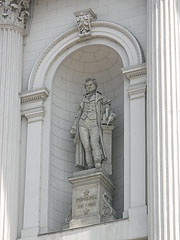 Statue of George Stephenson (1781-1848) English engineer on the main wall of the Keleti Railway Station
Statue of George Stephenson (1781-1848) English engineer on the main wall of the Keleti Railway Station
The statue is standing in the left side large sculpture niche, created by Ferenc Vasadi Ferenc in 1884.
The track gauge (the distance between the two rails) that was used by George Stephenson English engineer for his steam locomotives was 1435 mm. Finally this value became the standard track gauge for more than 60 percents of the railways in the world.
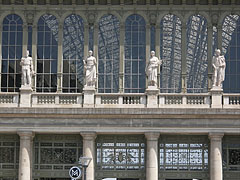 Four allegorical figures in the statue on the top of the Keleti Railway Station, above the main entrance
Four allegorical figures in the statue on the top of the Keleti Railway Station, above the main entrance
The four statues on the facade of the Keleti Railway Station over the main entrance were created by Gyula Bezerédi in 1884. But in the 1930s these were disappeared, seemingly mysteriously. For a while even the Russian (Soviet) army troops were suspicious that after the World War II they took the statues with themselves, but after analyzing some old photos it was revealed that the statues were disappeared from their place sometimes between 1935-1936. They were probably simply damaged and that's why removed from here. The statues were recreated in 2003 by Frigyes Janzer and Ferenc Gyurcsek.
These allegorical statues under the central clock refers to the close relationship between the railway and the other actors in the economy. Concretely: the miner represents the heavy industry, the spinning woman the light industry, the picker woman the agriculture, as well as the merchant symbolizes the trade and commerce.
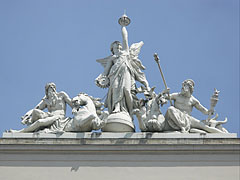 The allegorical statue on the top of the facade of the Keleti Railway Station
The allegorical statue on the top of the facade of the Keleti Railway Station
On the top of the front wall of the Keleti Railway Terminal at 43 meters high there is a sculpture group called "The allegory of the transportation". The composition represents the birth of the railway with a unique metaphor: between the gods of the fire and the water (in the ancient Roman mythology Vulcan and Nepune) a female figure symbolizes the birth of the steam.
The artwork needed to be completely recreated during the renovations of 1990, because the original tin plate statues were very ruined. Now the new statues were casted of aluminum alloy.
Considering the sculptor of the original statue from 1884 there is no clear consensus. Some sources say the maker was Gyula Bezerédi, others claim it was created by Ede Mayer and Béla Brestyánszky based on the idea and sketches of Leó Feszler (or Leo Fessler).
Будапешт - Другие галереи фото:
Вы также можете быть заинтересованы в (Связанные страницы):
Места назначения в путеводителе:
Будапешт (8 468 фотографии + 21 панорамные снимки)
Buda Hills (Budai-hegység) (8 632 фотографии + 21 панорамные снимки)
Пешт медье (15 122 фотографии + 50 панорамные снимки)
Будапешт и его окрестности (15 989 фотографии + 52 панорамные снимки)
Венгрия (27 287 фотографии + 163 панорамные снимки)
и кроме того:
(в здесь: Buda Hills)
Budakeszi (88 фотографии)
Pilisszentiván (76 фотографии)
Каждая панорама фото здесь:
Будапешт (21 фотографии)
Пешт медье (50 фотографии)
Будапешт и его окрестности (52 фотографии)
Венгрия (163 фотографии)
Европа (165 фотографии)
Все нормальные фотографии здесь:
Будапешт (8 468 фотографии / 122 галереи)
Buda Hills (Budai-hegység) (8 632 фотографии / 124 галереи)
Пешт медье (15 122 фотографии / 221 галереи)
Будапешт и его окрестности (15 989 фотографии / 234 галереи)
Венгрия (27 287 фотографии / 462 галереи)
Европа (30 494 фотографии / 523 галереи)
https://www.panadea.com/ru/guidebook/budapesht/photos/gal-040

Добавить в Избранное Добавь в Закладки
Поделитесь с вашими друзьями!
и т.д.
Наш путеводитель содержит:
Многочисленные фотографии и панорамные изображения, с большим количеством информации и интересных фактов.
- 214 места назначения
- 165 панорамные снимки
- 30 494 другие фотографии
Большая коллекция отобранных фотографий: превосходное качество, высокое разрешение и естественные цвета
О нас - Юридическая декларация -
Все права защищены
- ©2010-2022
Neuronit Creative Studio - Mogyoród / Будапешт / Венгрия
